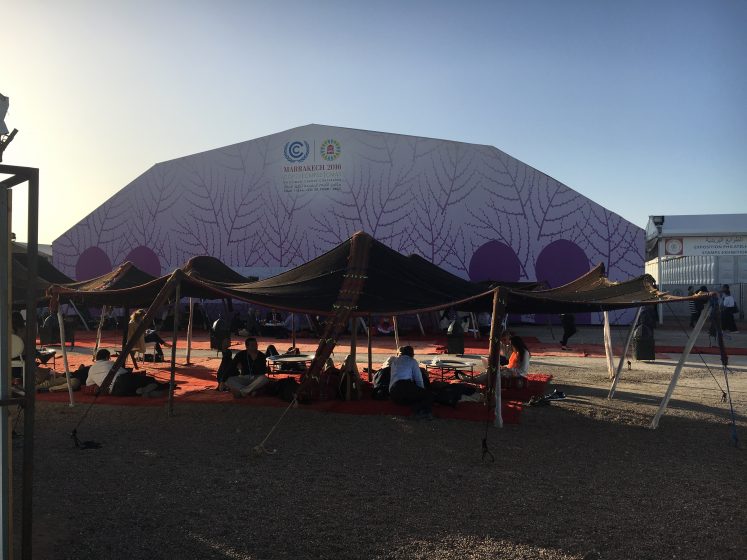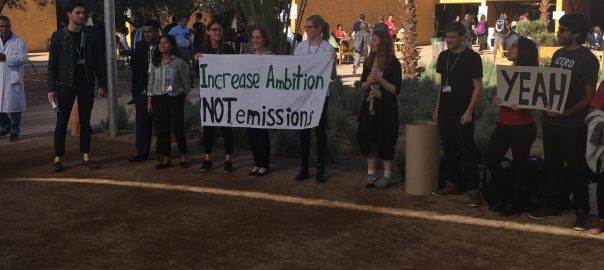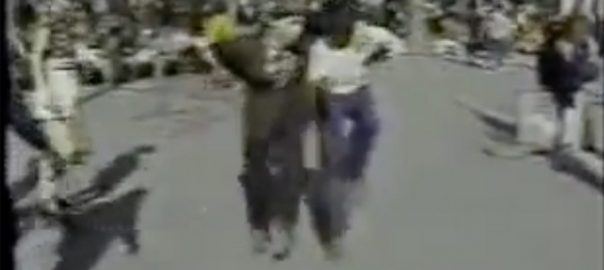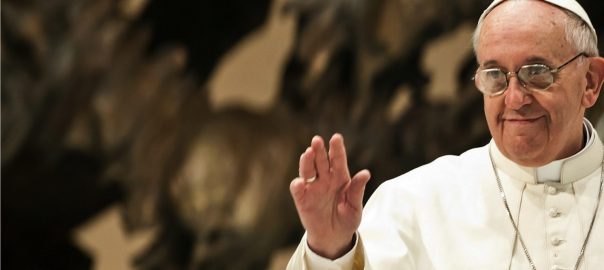We attended the 22nd session of the United Nations Climate Conference (also called COP22) as “Observers” in the immediate aftermath of the U.S. 2016 presidential election. Since 1995, the COP has served as the annual UN climate conference, providing an opportunity to assess progress, negotiate agreements, and disseminate information regarding global climate change action. This year’s COP was simultaneously exhilarating and uplifting, a message that we are determined to bring home to a country still reeling from an election that has elevated someone who called climate change a hoax to our nation’s highest office.
Thanks to its official Observer status, our employer, Drexel University, was one of hundreds of civil society institutions from around the world permitted to send a delegation to the two-week meeting in Marrakech, Morocco (7-18 November 2016). Our Office of International Programs and our Institute for Energy and the Environment sent an envoy of 10 faculty and students to this meeting, five each week. Our role as “observers” was none other than to attend the various summits, official meetings, and side events and to report on the actions that nation-states, indigenous peoples, businesses, mayors, and individuals are taking to address the challenges posed by climate change. We networked with other civil-service institutions, conducted an informal survey, listened to talks, and were interviewed by National Public Radio (11/21/16, State Impact NPR, “Pennsylvania Academics Find Inspiration at Climate Conference”).

The ongoing actions being discussed in Morocco would not have been possible if not for the historic agreement reached last year in Paris at COP21. The so-called “Paris Agreement” represented the first time that world leaders achieved global consensus regarding the need to work collaboratively to hold future global temperature increases to under 2 degrees Celsius. Over the last year, national governments had to formally ratify the agreement. Only 55 countries, accounting for 55 percent of global greenhouse gas (or GHG) emissions, needed to formally ratify the historic agreement for it to go into force; however, according to U.S. Secretary of State, John Kerry, speaking at the meeting in Marrakech, more than 109 countries—collectively responsible for 75 percent of global GHGs—had already signed prior to COP22, a much faster pace of ratification than anyone expected. Clearly, the need for global climate action has become a widely-held international value, shared not just by scientists and environmentalists, but also by governmental leaders, their rank and file governing bodies and agencies, and the private sector, whose interests underlie many political decisions.
With the signed agreement in force, conversations in the restricted Blue Zone of this year’s COP, focused on implementation strategies, identifying knowledge gaps, networking, and financing. The various meetings highlighted the efforts that individual countries have undertaken to identify the sources of their existing emissions, and gave them a platform to articulate their specific strategies for achieving their nationally determined contributions (or NDCs) to global GHG emission reductions. Discussions also addressed how specific countries, cities, and other sub-national actors are planning to nurture, manage, or shape forecasted economic and population growth, peacekeeping, and advances in human rights while keeping their emissions under control. Again according to Secretary Kerry, each nation is now in the process of developing its own plan, tailored to its own circumstances, and according to its own abilities. It is an example of common but “differentiated responsibilities”, with the most vulnerable nations being helped along by those most equipped to address this challenge.
In the publicly-accessible Green Zone of the meeting, attendees were largely focused on the role that the private sector and civil society can and must play. In small and large booths, vivid displays highlighted everything from the voluntary emission reduction goals of large multi-national corporations to small-scale entrepreneurial efforts to innovate new ways of deriving fuel from waste, or to create new market opportunities for existing technologies such as the “Nigerian Refrigerator,” which can cool a pot of fruit from 40°C to 4°C relying solely on evaporative processes. The Green Zone included interactive meetings where individuals could spontaneously join group discussions focusing on climate justice, racism, and other struggles intimately related to climate change. It also featured an international, socially-engaged art exhibit.

Marrakech, a beautiful city situated at the foot of the Atlas Mountains and at the edge of the Sahara Desert, was the perfect backdrop for this kind of multi-faceted exchange of ideas. Each day, as our group walked through its central square, the Jemaa el-Fna, a dynamic urban space packed with storytellers and snake charmers, musicians and dancers, traders and merchants, street food vendors, and children, we thought, what better setting to host the growing cross-cultural, global dialogue regarding the planet’s future? The square’s air is full of smoke, smells, sounds, and slang; its perimeter is lined with shops, rooftop restaurants, and street-level cafés. A vibrant, multi-actor, pulsating center of contrasts between old and new, of negotiation and of barter, it represents, in miniature, what is now happening on the world stage between global leaders, policymakers, entrepreneurs, and other vested individuals.
But what was most exhilarating to witness was how integrated the global response to climate change has become inside other contemporary efforts to improve the human condition. COP22 is just the most recent of a historic string of new pacts and agreements that will collectively guide the next phase of global human development. It began in 2015, when the United Nations officially replaced its Millennium Development Goals (or MDGs) with 17 Sustainable Development Goals (or SDGs), and 169 carefully articulated and intimately-related targets. The SDGs point the way to the next wave of progress on poverty alleviation, environmental protection, and the spreading of economic prosperity. A few months later, in March 2015, and at the request of the UN General Assembly, the Sendai Agreement for Disaster Risk Reduction—another global pact focusing on resilience and reducing the impacts of disasters on lives, livelihoods, health, and economic, physical, social, cultural and environmental assets—was adopted. The Paris Agreement was signed on December 12, 2015, and went into effect less than one year later on 5 October 2016. On October 15, 2016, after the conclusion of all-night negotiations in Kigali, Rwanda, an agreement was reached to limit the use of hydrofluorocarbons (or HFCs) resulting in the largest potential temperature reduction ever achieved by a single agreement, as much as 0.5 C. Later in October of 2016, in Quito, Ecuador, the United Nations Conference on Housing and Sustainable Urban Development (called Habitat III) concluded with the adoption of the New Urban Agenda, a document that establishes new global standards for sustainable urban development, focusing on the collaborations necessary to more sustainably build, manage, and live in cities.
The “conversation” in Marrakech focused on how policymakers, planners, designers, business leaders, and individuals from all corners of the globe can integrate all of these different goals and aspirations into actionable initiatives at local, regional, national, and international scales. How can we design safe, accessible cities, with low-carbon transport systems, stable governing bodies, and equitable access to resources? How can we re-imagine our coastlines as multifunctional living landscapes, equipped to adapt to rising sea levels, but also supportive of critical fisheries, emergent habitats, and other forms of biodiversity? Where and how, in geographical and economic terms, will we feed ourselves, live, earn a living, and play, as both the global and urban populations of the world reach historical proportions? What successful models have been piloted, and what can we learn from them? These and other related, intellectually stimulating, and fundamentally important questions were on the lips of just about everyone we bumped shoulders with on the sprawling conference grounds.
Personally, we were reassured to witness this important conversation elaborated in so many different ways, by so many different people, in so many different languages, at COP22, even as the U.S. prepares for a new president. President-elect Donald Trump’s dismissive rhetoric during the campaign, and the expressed views of many individuals he appears poised to appoint as part of his Cabinet, suggest that this administration may not instinctively understand the urgency of global collaboration on any of these issues. Where the Obama administration has lead, the incoming administration seems, at least initially, to want to close the door. Like many other Americans attending the meeting, we used phrases like “angrily charged” and “disillusioned, but determined” to describe our post-election feelings at a workshop organized at the conference by Mediators Without Borders (or MWB) as an outlet for attendees to express our emotional reactions to the election results, and to convert these into a constructive reorientation of our professional activities.
To elicit global perspectives on the election, our Week Two delegation designed an informal survey to conduct after the MWB workshop, as we circulated among the tens of thousands of conference attendees. It featured two core questions: “What was your reaction when you heard the results of the U.S. election?” and, “Do you have a message for the incoming U.S. Administration regarding climate change?” Though we would be remiss not to mention that among the conference attendees were certainly a small group individuals who were unsurprised, or even satisfied, by Mr. Trump’s victory, responses to the first question overwhelmingly reflected many of the same feelings of shock, horror, and devastation articulated in the MWB workshop. But regardless of their feelings about Mr. Trump, and without exception, respondents to the second survey question urged the President Elect to follow his predecessor’s example by collaborating with the international community on efforts to battle climate change and to also lead in related struggles for sustainable development.
Leaders from all levels of government have expressed the same sentiment, tinged with optimism that significant backpeddling may no longer be tenable. UN Secretary General Ban ki-Moon said he counts “on the U.S.’s continued engagement and leadership to make this world better for all…” Brian Deese, Senior Climate Advisor to President Obama, reported in Marrakech that for the first time in human history, carbon emissions are now completely decoupled from economic growth. And Jonathan Pershing, the U.S. Special Envoy on Climate Change, stated confidently that, “The transition to clean energy is now inevitable.” While we still have many profound challenges, “the momentum is insurmountable: there is no stopping,” he said. Indeed, the recent open letters from more than 300 companies and from 37 red band blue state mayors asking President-Elect Trump not to abandon the Paris Agreement is further evidence of the deep roots that this movement now has.

For all these reasons, we returned Stateside full of renewed excitement, resolve, and hope. We are not naïve to the struggles we may have to face domestically, but we feel more energized, focused, and determined than ever before about the importance of the work we are all doing. The time to perfect our analyses, demonstrate our ideas, publish our work, talk to our neighbors, and to let our values drive our personal and professional activities is now. We must be the change and action that we want to see in the world.
This month, Drexel became the North American Hub of the Urban Climate Change Research Network. We have listed two preliminary goals to guide our activities: we will continue to generate and to disseminate scientific knowledge where it can inform sound decisions and policy, and to support our practitioner colleagues in their efforts to implement change. But in other contexts—ones where change must be catalyzed through other means—we are prepared to apply other forms of pressure, drawing from the enormous fountain of energy, creativity, and connections available to us through the growing international demand for climate action, social justice and sustainability. We invite you to join us as we transition from debates to determined action at all levels of our global community.
Franco Montalto and Hugh Johnson
Philadelphia
about the writer
Hugh Johnson
Hugh has consulted on various aspects of renewable energy and energy efficiency for private, municipal, and federal clients. At Drexel, he contributes technical expertise and manages special projects.












Add a Comment
Join our conversation